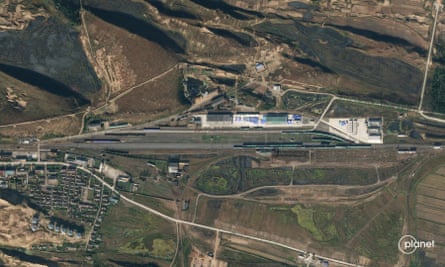A lively group of people, holding pom poms and flowers, welcomed the Russian foreign minister as he arrived in Pyongyang amidst the heavy rain at the airport.
Although highly staged welcomes are often seen in authoritarian North Korea, Sergei Lavrov’s uncommon trip to the nation coincided with increasing evidence that Pyongyang has begun to supply artillery rounds to Russia. This could potentially have significant consequences for the conflict in Ukraine.
In recent weeks, the United States reported that up to 1,000 shipping containers from North Korea containing “equipment and munitions” have been sent to Russia.

The White House shared satellite images that showed about 300 containers being gathered in Najin, a harbor in northern North Korea, and transported by both sea and rail to a storage area near Tikhoretsk in southern Russia, approximately 180 miles away from the border of Ukraine.
The Royal United Services Institute (Rusi), a thinktank based in London, has confirmed US intelligence reports stating that Russia is likely exporting North Korean weapons on a large scale. Last week, Rusi published a report with this conclusion.
After examining detailed satellite pictures, Rusi reported that three cargo ships belonging to Russia’s military had been traveling back and forth between North Korea’s Rajin port and a confidential port in Dunai, located in the far east of Russia. This activity occurred at least five times since mid-August.

The think tank reported that the ships departed shortly after Russian defense minister Sergei Shoigu’s visit to North Korea, during which he was shown the country’s latest weapons by leader Kim Jong-un. Kim has since visited Russia’s far east and expressed his full support for Moscow’s “sacred fight” against western powers.
Following the meeting between Kim and Putin, the Beyond Parallel project, based at the Center for Strategic and International Studies in Washington, examined satellite images that revealed a significant increase in freight railcar activity at North Korea’s Tumangang rail facility near the Russian border.
According to its report, the amount of trains passing through the facility has significantly increased in the past five years, surpassing even pre-Covid-19 levels. This is noteworthy as it coincides with discussions between Kim and Putin about military cooperation, suggesting that the surge in rail traffic may be related to North Korea supplying arms and munitions to Russia.
The Russian government has continuously denied allegations from Western countries that it has been purchasing weapons and ammunition from North Korea.

Despite a focus on newer, high-tech weapons, analysts have deemed artillery to be of utmost importance in the ongoing conflict between Ukraine and Russia, often referring to it as the “king of battle”.
Joe Byrne, a research analyst at Rusi, stated that if it is confirmed, the provision of large amounts of munitions by North Korea to Moscow could have significant implications for the conflict in Ukraine. Byrne also shared that Russia would not be seeking assistance from North Korea unless necessary and that a major supply line from North Korea would help satisfy their need for munitions.
Maj Patrick Hinton, an artillery officer in the British army and recent visiting fellow at Rusi who closely studies the war in Ukraine, said North Korea had a large stockpile of artillery shells and rockets that were compatible with the Soviet and Russian weapons systems being used by Moscow.
According to him, North Korea likely provided two types of weapons commonly used by Russia during war: 122mm howitzer shells from the Soviet era and 122mm Grad rockets.
According to Hinton, despite facing sanctions, North Korea still has the capacity to produce large amounts of ammunition and has accumulated substantial amounts of it. This has been a top priority for them.

The exact quantity of artillery pieces that the United States believes North Korea has transferred to Russia has not been specified.
According to Col Ants Kiviselg, the leader of military intelligence in the Estonian defense forces (EDF), the reported shipment of 1,000 sea containers to Russia contained approximately 300,000-350,000 artillery units.
At a press conference last Friday, he mentioned that the Russian troops use 10,000 pieces of artillery ammunition daily. This quantity could potentially last for about a month. The delivery of supplies from North Korea suggests that Russia intends to prolong its involvement in the Ukrainian war and is actively taking measures to do so.
There are still uncertainties surrounding the caliber of weapons provided by Pyongyang.
In 2010, the North Korean military launched approximately 170 shells at Yeonpyeong, South Korea, with over half of them landing in the surrounding waters of the island.
According to Hinton, subpar ammunition may not perform consistently, but due to the high quantities used and a lack of precision, the occasional misfires would not have a significant impact. Essentially, quantity outweighs quality in this scenario.
Moscow has increased its domestic missile production levels, surpassing those before the war. Under Putin’s leadership, the production of military equipment has become a top priority for Russia, with a planned defense spending increase of nearly 6% of the gross domestic product in 2024. This follows a 3.9% increase this year and a 2.7% increase in 2021.
In the previous month, Rostec, the largest weapons manufacturer in Russia owned by the state, reported a significant growth in production for different types of weapons ranging from two to 10 times.
According to Jack Watling’s report titled “Ukraine Must Prepare for a Hard Winter,” Russia’s production of long-range missiles has significantly increased. In October 2022, they were producing about 40 missiles per month, but now they are producing over 100 per month.
Due to the lack of progress in Ukraine’s summer attack and the change in military resources, it is crucial for Kyiv to proceed with caution in order to maintain control.
Source: theguardian.com
















